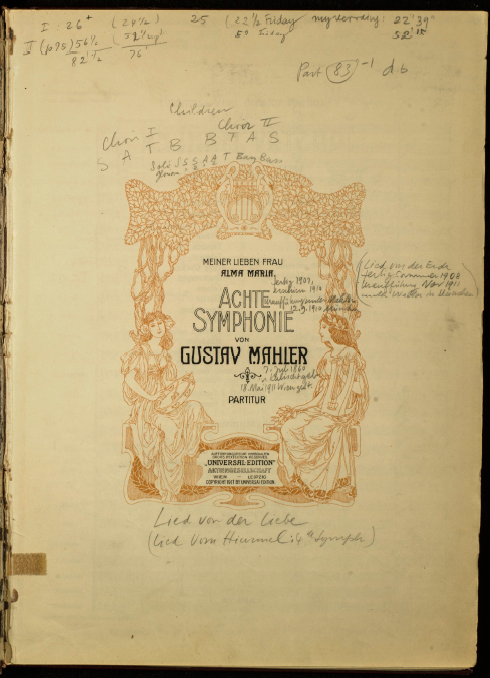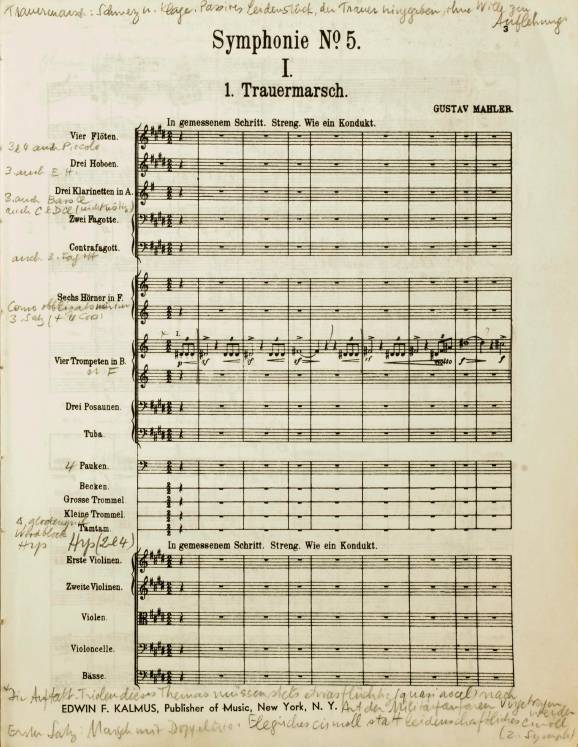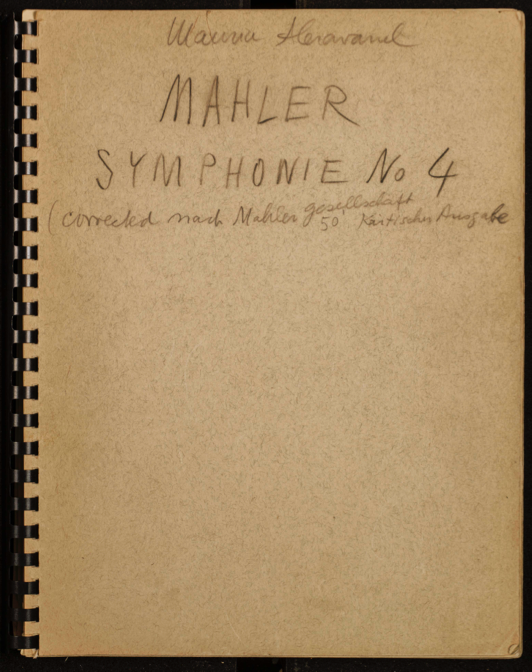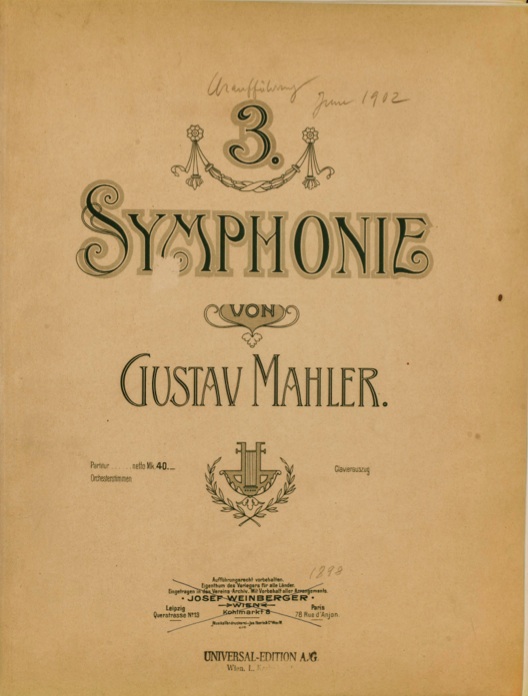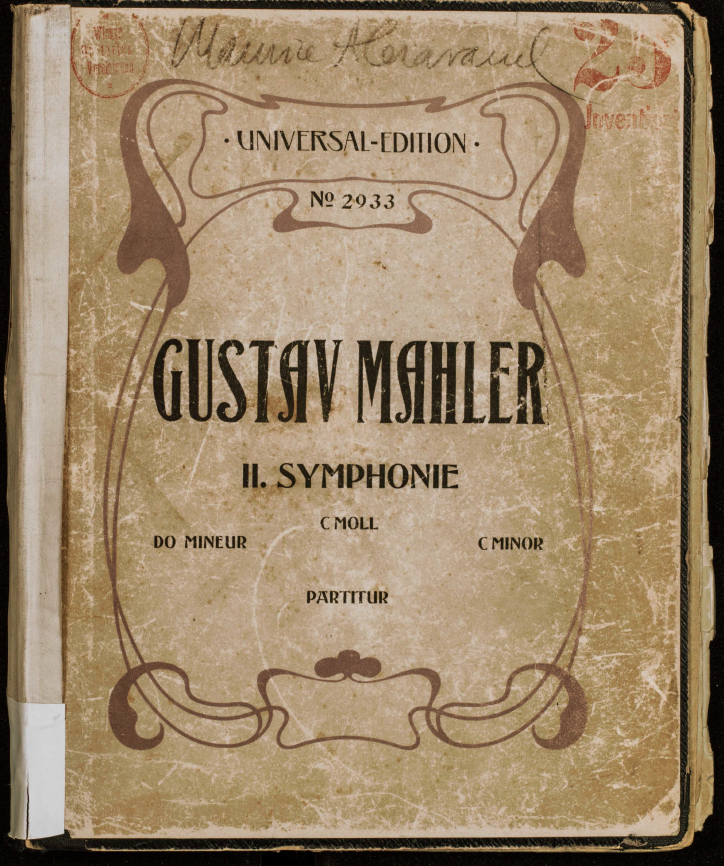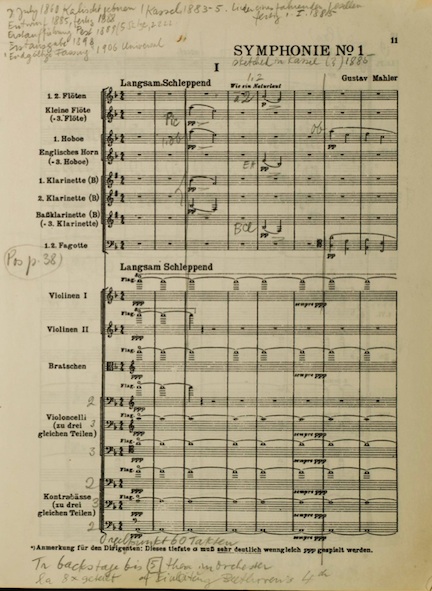Mahler Cycle Celebration, 2014 – 2016
McKay Music Library in Partnership with the Utah Symphony
We published the Mahler symphonies to the digital archive as each symphony was performed. Entries below are in reverse order with the first performance of the cycle (Mahler's First Symphony) at the bottom.
For the Week of February 15-21, 2016
Mahler's Symphony No. 8
See the score of the first movement of this symphony by selecting the image below. The entire symphony has been uploaded in two parts: Part I and Part II.When Abravanel received his Mahler award from the Bruckner Society in 1965, he commented that,
“This particular medal came about mostly because of the performance of Mahler’s Eighth Symphony. This was a mad undertaking. I heard it as a young man when I was nineteen in Berlin. It was one of the first concerts I heard and I was deeply impressed. I went to all the concerts and I heard the rehearsal of Bruno Walter. I heard many Mahler symphonies and I bought them, and believe me I did go without a meal. As a matter of fact, for three months I went without luncheon.”
The performance of this symphony on February 19th and 20th almost brings the Mahler cycle to a close. What a wonderful two years it has been!
copyright, Lisa Chaufty, library director, under a CC BY-NC-SA 4.0 license.
For the Week of January 8-9, 2016
Mahler's Symphony No. 7
Please access the indiviual movements for this symphony at the links below:
For the Week of November 16-22, 2015
Mahler's Symphony No. 6
See the score of the first movement of this symphony by selecting the image below. The entire symphony has been uploaded. See the second movement, here; the third movement, here; and the finale, here.
**Note that these scores have been scanned at a very high resolution to enable one to read the markings; therefore for the optimal viewing experience, you may need to download the object and view it on your computer to avoid the time that loading each image may take when viewed in your Web browser.
Of particular interest:
copyright, Lisa Chaufty, library director, under a CC BY-NC-SA 4.0 license.
For the Week of November 2-8, 2015
Mahler's Symphony No. 5
See the score of the first movement of this symphony by selecting the image below. The entire symphony has been uploaded. See the second movement, here; the third movement, here; the fourth movement, here; and, the finale, here.
**Note that these scores have been scanned at a very high resolution to enable one to read the markings; therefore for the optimal viewing experience, you may need to download the object and view it on your computer to avoid the time that loading each image may take when viewed in your Web browser.
For the Week of May 18-22, 2015
Mahler's Symphony No. 4 in G Major
See the score of Movement I of this symphony by selecting the image below. Please contact the McKay Library or visit us if you would like to see the remaining movements.
**Note that these scores have been scanned at a very high resolution to enable one to read the markings; therefore for the optimal viewing experience, you may need to download the object and view it on your computer to avoid the time that loading each image may take when viewed in your Web browser.
For the Week of February 2-7, 2015
Mahler's Symphony No. 3 in D Minor
See the score of the first movement of this symphony by selecting the image below. The entire symphony has been uploaded. See the second movement, here; the third movement, here; the fourth movement, here; the fifth movement here; and, the finale, here.
**Note that these scores have been scanned at a very high resolution to enable one to read the markings; therefore for the optimal viewing experience, you may need to download the object and view it on your computer to avoid the time that loading each image may take when viewed in your Web browser.
Of particular interest:
As with his other Mahler symphony scores, Maurice Abravanel wrote descriptive notes highlighting certain passages of the symphony. We have discovered the source of these notes within our collection of the books about Mahler's works that were owned by Abravanel: Gustav Mahlers Sinfonien, by Paul Bekker. This survey of Mahler’s symphonies was published in 1921. Abravanel’s copy is signed and notated “Berlin, 1922.” Bekker was a reviewer in Berlin, before moving to Kassel to conduct. In all likelihood, Bekker and Abravanel knew each other. Bekker's book has long been regarded as an important critical work within the history of Mahler studies; however, it was just recently translated into English as part of a dissertation.
copyright, Lisa Chaufty, library director, under a CC BY-NC-SA 4.0 license.
For the Week of November 14-15, 2014
Mahler's Symphony No. 2 in C Minor
See the score of the first movement of this symphony by selecting the image below. The entire symphony has been uploaded. See the second movement, here; the third movement, here; the fourth movement, here; and, the finale, here.
**Note that these scores have been scanned at a very high resolution to enable one to read the markings; therefore for the optimal viewing experience, you may need to download the object and view it on your computer to avoid the time that loading each image may take when viewed in your Web browser.
Within Maurice Abravanel’s score collection, there are several editions of the second symphony. The edition that he used for score preparation and conducting is the Universal Edition from 1897, the first edition. It is well worn, mended over the years with tape on the spine and on some of the pages. The score is now very delicate. In cases like this, digitizing the score has preserved not only the physical copy from further wear and tear, but has preserved access to the work through its digital instantiation.
This score is fascinating and has an interesting provenance. Note the stamps on the cover and title page. This score was number 25 in the inventory of the Wiener Oratorien Vereinigung (the Vienna Oratorio Society). I wonder how Abravanel obtained it? Did he have a connection to the Vienna Oratorio Society? Or, did he purchase it second-hand from them or someone else?
Tucked within the score, there are several loose sheets, most notably: a 1967 review of the recording of the second from Hi-fidelity magazine, and a handwritten analysis of the symphony’s themes and formal divisions. There is also a letter with a set of pages compiling of all of the corrections to the work that would be part of the new critical edition, to be published in 1970 by Universal in partnership with the International Gustav Mahler Society. All of these edits were applied in pencil to this 1897 edition of Abravanel’s. Even though Abravanel conducted the symphony after 1970, when the critical edition was published, there are no markings of significance in the 1970 edition. There is every indication that Abravanel only used this 1897 score (his first, most probably) to conduct all of the performances of this symphony.
copyright, Lisa Chaufty, library director, under a CC BY-NC-SA 4.0 license.
For the Week of September 13-14, 2014:
Mahler's Symphony No. 1 in D Major
See the score of Movement I of this symphony by selecting the image below. Please contact the McKay Library or visit us if you would like to see the remaining movements.
**Note that these scores have been scanned at a very high resolution to enable one to read the markings; therefore for the optimal viewing experience, you may need to download the object and view it on your computer to avoid the time that loading each image may take when viewed in your Web browser.
Of particular interest: Tipped into the score between the first and second movements is the "Blumine" movement, which was the original second movement in the original version of the symphony, as performed by Mahler in 1889, in Budapest.
Mahler's original version included five movements and a program, as follows:
Part One: Aus den Tagen der Jugend
- Frühling und kein Ende
- Blumine
- Mit vollen Segeln
Part Two: Comedia humana
- Todtenmarsch in Callots Manier
- D'all inferno al'Paradiso
Post-1894, Mahler published the symphony without the "Blumine" movement, and without the program.

